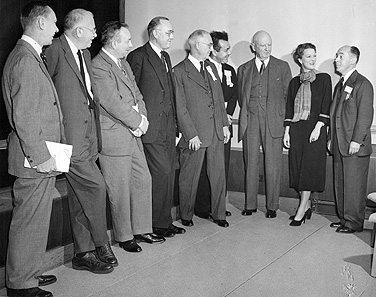Flashback
60 years ago
UB looks to the future

UB Council Chair Seymour H. Knox, right, with participants in the forum on the future of the creative arts. They are, from left, Edgar Schenck, Ben Shahn, Philip Rhys Adams, Andrew Ritchie, William Carlos Williams, Alexander Schneider, A. Conger Goodyear and Margaret Webster. Photo: UB ARCHIVES
Does mankind stand a chance? Is war inevitable? Will the American system of government survive? How secure will you be? Just what does the future offer?
These were just some of the weighty questions examined by participants in UB’s Niagara Frontier Convocation, “The Outlook for Mankind in the Next Half Century,” held Dec. 7-8, 1951. The convocation consisted of a series of panel discussions and addresses on science, technology, creative art, freedom, industry and health.
In July 1950, UB’s Committee on University Development began planning for a convocation that would bring leaders from various fields to Buffalo to help evaluate and seek solutions to the major problems facing in nation in the second half of the 20th century.
There were ambitious ideas for the convocation. In addition to President Harry S. Truman, invitations were extended to Winston Churchill, Katherine Cornell, John Foster Dulles, Dwight D. Eisenhower, Enrico Fermi, Alexander Fleming, Henry Ford II, Trygve Lie, George Marshall, Eleanor Roosevelt, David Sarnoff, Eliel Saarinen and Thomas J. Watson.
Tentative programs were developed with these invitees as participants. While none of these world figures accepted the invitation, some did write letters in support of the convocation’s goal.
Participants in seven symposia sought answers to such questions as: What moral and spiritual values will survive? Will science and technology transform our lives? Will the creative arts thrive or degenerate? Can we have peace and freedom? What progress will there be in health care? Can democratic government survive? What are the new horizons in business and industry?
The symposia, which were held in the auditorium of Hayes Hall and in Kleinhans Music Hall, attracted capacity crowds. One account of the conference claimed that “Everybody on the frontier turned out!”
The forum on the future of the creative arts attracted as participants Edgar Schenck, director of the Albright-Knox Art Gallery; artist Ben Shahn; Philip Rhys Adams, director of the Cincinnati Museum of Art; Andrew Ritchie, from the Museum of Modern Art; physician and poet William Carlos Williams; violinist Alexander Schneider; A Conger Goodyear, arts patron and a founder of the Museum of Modern Art; and actress and director Margaret Webster.
The remarks made by the participants in the forum on the future of the creative arts were published as the February 1952 issue of the “University of Buffalo Studies.”
Planning documents, correspondence between the planners and invitees, and proceedings of the convocation are held by the University Archives.
—John Edens, University Archives

Reader Comments